
Taxonomy;
Class: Insecta Order: Blattodea Family: Blaberidea Genus: Gromphadorhina Species: portentosa
Origin;
As their common name suggests, the hissing cockroach is found on Madagascar, off the east coast of Africa. They’re found in the lowland tropical forests, scuttling around in the dry, crispy leaf litter on the forest floor. Due to the island’s landscape, they mostly inhabit the east coast, with patches of colonies dotted around other suitable lowland locations.

Free satellite-generated image
In the east, heavy rainfall can happen at any time of the year, so don’t expect your pets to be happy sitting in a dry bin full of egg cartons. The temperatures here can reach 32 °C in summer and drop as low as 18 °C in the winter months (May to October), giving this species a wide range of temperature and humidity tolerances. If you’re planning a trip of a lifetime to this island, then remember to pack plenty of clothes and the same kagool you would take to Wales!
Description;
One of the most obvious differences with this roach and many others is the lack of wings. Their colour ranges from black to a mahogany brown, with the sternite segments making some of them appear to have stripes. Males possess pronotal lumps (horns) that are larger than those of the females, making them easy to sex. They are often confused with other hissing cockroaches like the Halloween hissing cockroach (Elliptorhina javanica) due to the overuse of common names. If purchasing these, it is always best to request their scientific name so you know what you are going to receive.
As portentosa is one of the largest cockroaches in the world, at over 2 inches (up to 7.5 cm), people have “promoted” this cockroach to become a pet instead of a feeder, which it was first brought into the hobby to be.
Hissing;
This species’ common name isn’t an accident, and they will hiss when touched or picked up. The hiss is generally used in courtship and colony hierarchy interactions and is very audible to the human ear. Air is forcibly expelled through their spiracles (spiracles are tubes that line the body of an insect, which enable it to breathe), making a sound similar to a vertebrate using vocal chords, unlike the familiar sound of crickets that rub body parts together or cicades that use a vibrating membrane to make their sounds.
Diet;
As detritivores portentosa are designed by nature to eat decaying matter, but fresh items will also be readily taken. Fresh fruits, vegetables, dead insects, dog and cat biscuits, rabbit pellets, and even beetle/ gecko jellies will be consumed by these prolific creatures.
Flies;
Due to their diet, this can attract flies in abundance. Fungus gnats and fruit flies are not unusual inhabitants of your portentosa enclosure (and any other roach species), and for this reason, it is always best not to overfeed; little and often is a much better regime, and removing any uneaten foodstuffs will lower the number of flies.
As a feeder;
Not many invertebrates will take on adults of this cockroach; some of the larger adult praying mantis and adult tarantulas will tackle them, but using nymphs of this prolific species is easier for all.
Warning: This animal will scream when caught and eaten, which can be rather upsetting to some.
Enclosure;
There are many suggestions on the “best way” to keep this cockroach throughout the internet and YouTube, from dry to bioactive. I find a mix of the two to be the best option. A large, tall plastic storage box, preferably dark in colour or at least opaque, with a shallow amount of substrate to absorb feces and urine from the animal (this also prevents them from smelling) and lots of hiding places should be provided such as cork bark. Egg cartons may also be used, but they will need to be replaced frequently as they absorb moisture and can grow mould. A clear area where food can be introduced is also advised.
Warning: This cockroach is capable of climbing smooth surfaces. A 1-2 inch band of Vaseline around the lip of the tub or tank is advised to prevent them from climbing out, which will require re-application from time to time.
Breeding;
A small starter colony of 5 or 10 that includes both male and female roaches is enough to get a large colony off the ground. More females than males is the preferred ratio as they are territorial in nature.
Being ovoviparous (giving birth to live young), there is no ootheca care required. Eggs and neonate nymphs are carried within the female for up to 60 days before they emerge as fully formed miniature roaches. I litter of 40-70 younger may emerge in one birth, they’re born devoid of colour and are white.
Nymphs have 6 more moults before reaching the adult stage, which takes approximately 7 months to achieve.
Photographs and author: Simon Griffiths, The Mantis Garden
Was this helpful?
1 / 0